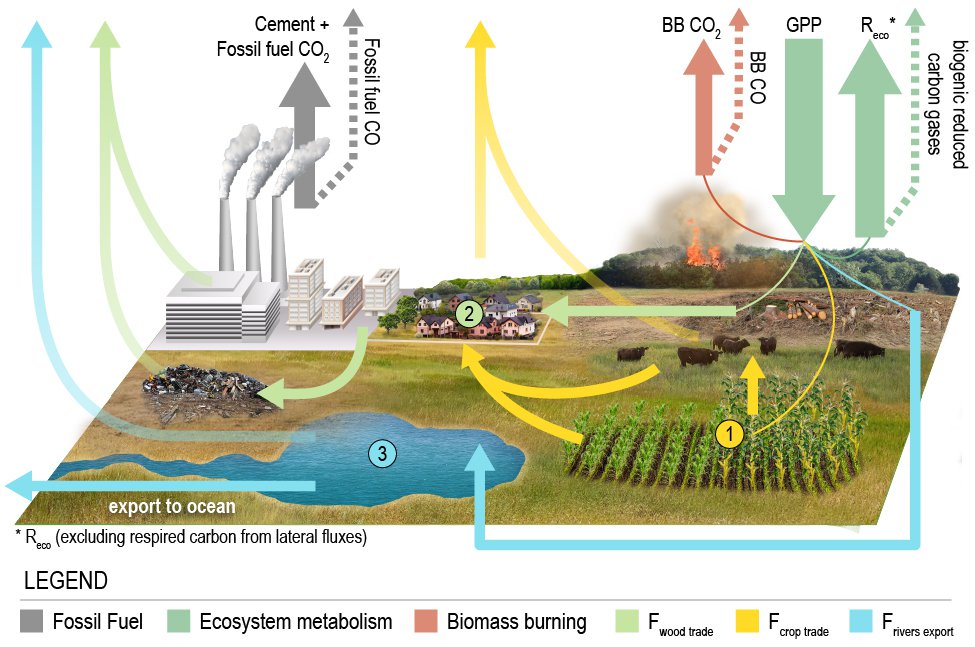What are the emissions and removals of CO2 (carbon dioxide) for countries around the world? And how much do fossil fuel emissions, trade, and changing land carbon stocks contribute to these net fluxes?
These are questions that Brendan Byrne, a post-doctoral fellow at Jet Propulsion Laboratory, is trying to answer with his participation in a project to estimate national carbon dioxide budgets, in support of the Global Stocktake, a process designed to take stock of the implementation of the international treaty on climate change, the Paris Agreement.
To develop CO2 budgets, the net fluxes are estimated using data from the Orbiting Carbon Observatory-2 (OCO-2), a remote sensing satellite instrument managed by JPL that collects space-based observations of carbon dioxide. These estimates are made from a series of models in the OCO-2 Model Intercomparison Project (OCO-2 MIP) that infer emissions and removals from observed increases or decreases in atmospheric carbon dioxide by OCO-2.
The net fluxes of CO2 derived from the OCO-2 MIP are due to the combined effect of fossil fuel emissions and a number of biologic processes (e.g., agriculture, forestry, deforestation, fires). Combining these data with complementary datasets on fossil fuel emissions and trade statistics, the net fluxes of CO2 for each country are decomposed into five component fluxes: Fossil fuel emissions, crop trade, wood trade, river carbon export, and changes in land carbon stocks, which are reported annually over 2015-2020.

Fig. Fluxes to consider Credit: Randall Oliver
This pilot dataset is aimed at informing countries’ carbon budgets, and in particular, informing changes in carbon stocks in both managed and unmanaged lands, which are generally the most uncertain aspect of countries’ carbon budgets. This pilot dataset is expected to be improved upon as carbon dioxide observing systems and flux estimation systems are improved.
References:
Global Stocktake:
https://unfccc.int/topics/global-stocktake
OCO-2 Mission Overview
https://ocov2.jpl.nasa.gov/mission/
Dataset:
Byrne, B., Baker, D. F., Basu, S., Bertolacci, M., Bowman, K. W., Carroll, D., Chatterjee, A., Chevallier, F., Ciais, P., Cressie, N., Crisp, D., Crowell, S., Deng, F., Deng, Z., Deutscher, N. M., Dubey, M. K., Feng, S., García, O. E., Herkommer, B., Hu, L., Jacobson, A. R., Janardanan, R., Jeong, S., Johnson, M. S., Jones, D. B. A., Kivi, R., Liu, J., Liu, Z., Maksyutov, S., Miller, J. B., Miller, S. M., Morino, I., Notholt, J., Oda, T., O’Dell, C. W., Oh, Y.-S., Ohyama, H., Patra, P. K., Peiro, H., Petri, C., Philip, S., Pollard, D. F., Poulter, B., Remaud, M., Schuh, A., Sha, M. K., Shiomi, K., Strong, K., Sweeney, C., Té, Y., Tian, H., Velazco, V. A., Vrekoussis, M., Warneke, T., Worden, J. R., Wunch, D., Yao, Y., Yun, J., Zammit-Mangion, A., and Zeng, N.: Pilot top-down CO2 Budget constrained by the v10 OCO-2 MIP Version 1, Committee on Earth Observing Satellites, https://doi.org/10.48588/npf6-sw92 Version 1.0, 2022.
Pre-print:
Byrne, B., Baker, D. F., Basu, S., Bertolacci, M., Bowman, K. W., Carroll, D., Chatterjee, A., Chevallier, F., Ciais, P., Cressie, N., Crisp, D., Crowell, S., Deng, F., Deng, Z., Deutscher, N. M., Dubey, M., Feng, S., García, O., Griffith, D. W. T., Herkommer, B., Hu, L., Jacobson, A. R., Janardanan, R., Jeong, S., Johnson, M. S., Jones, D. B. A., Kivi, R., Liu, J., Liu, Z., Maksyutov, S., Miller, J. B., Miller, S. M., Morino, I., Notholt, J., Oda, T., O’Dell, C. W., Oh, Y.-S., Ohyama, H., Patra, P. K., Peiro, H., Petri, C., Philip, S., Pollard, D. F., Poulter, B., Remaud, M., Schuh, A., Sha, M. K., Shiomi, K., Strong, K., Sweeney, C., Té, Y., Tian, H., Velazco, V. A., Vrekoussis, M., Warneke, T., Worden, J. R., Wunch, D., Yao, Y., Yun, J., Zammit-Mangion, A., and Zeng, N.: National CO2 budgets (2015–2020) inferred from atmospheric CO2 observations in support of the Global Stocktake, Earth Syst. Sci. Data Discuss. [preprint], https://doi.org/10.5194/essd-2022-213, in review, 2022